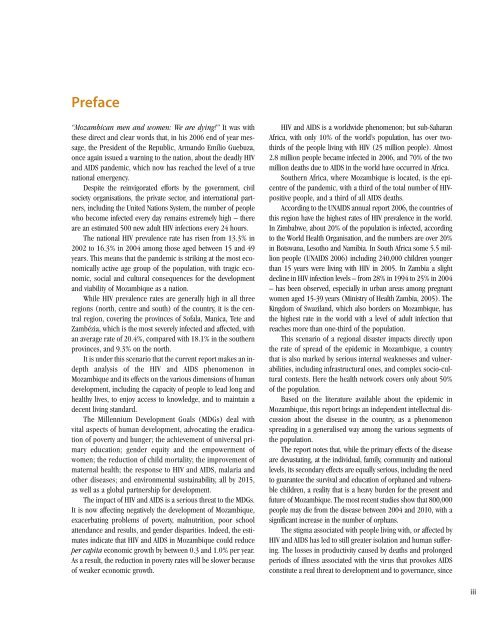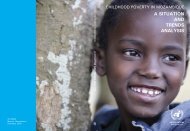English language version - Human Development Reports - United ...
English language version - Human Development Reports - United ...
English language version - Human Development Reports - United ...
- No tags were found...
Create successful ePaper yourself
Turn your PDF publications into a flip-book with our unique Google optimized e-Paper software.
Preface“Mozambican men and women: We are dying!” It was withthese direct and clear words that, in his 2006 end of year message,the President of the Republic, Armando Emílio Guebuza,once again issued a warning to the nation, about the deadly HIVand AIDS pandemic, which now has reached the level of a truenational emergency.Despite the reinvigorated efforts by the government, civilsociety organisations, the private sector, and international partners,including the <strong>United</strong> Nations System, the number of peoplewho become infected every day remains extremely high – thereare an estimated 500 new adult HIV infections every 24 hours.The national HIV prevalence rate has risen from 13.3% in2002 to 16.3% in 2004 among those aged between 15 and 49years. This means that the pandemic is striking at the most economicallyactive age group of the population, with tragic economic,social and cultural consequences for the developmentand viability of Mozambique as a nation.While HIV prevalence rates are generally high in all threeregions (north, centre and south) of the country, it is the centralregion, covering the provinces of Sofala, Manica, Tete andZambézia, which is the most severely infected and affected, withan average rate of 20.4%, compared with 18.1% in the southernprovinces, and 9.3% on the north.It is under this scenario that the current report makes an indepthanalysis of the HIV and AIDS phenomenon inMozambique and its effects on the various dimensions of humandevelopment, including the capacity of people to lead long andhealthy lives, to enjoy access to knowledge, and to maintain adecent living standard.The Millennium <strong>Development</strong> Goals (MDGs) deal withvital aspects of human development, advocating the eradicationof poverty and hunger; the achievement of universal primaryeducation; gender equity and the empowerment ofwomen; the reduction of child mortality; the improvement ofmaternal health; the response to HIV and AIDS, malaria andother diseases; and environmental sustainability, all by 2015,as well as a global partnership for development.The impact of HIV and AIDS is a serious threat to the MDGs.It is now affecting negatively the development of Mozambique,exacerbating problems of poverty, malnutrition, poor schoolattendance and results, and gender disparities. Indeed, the estimatesindicate that HIV and AIDS in Mozambique could reduceper capita economic growth by between 0.3 and 1.0% per year.As a result, the reduction in poverty rates will be slower becauseof weaker economic growth.HIV and AIDS is a worldwide phenomenon; but sub-SaharanAfrica, with only 10% of the world’s population, has over twothirdsof the people living with HIV (25 million people). Almost2.8 million people became infected in 2006, and 70% of the twomillion deaths due to AIDS in the world have occurred in Africa.Southern Africa, where Mozambique is located, is the epicentreof the pandemic, with a third of the total number of HIVpositivepeople, and a third of all AIDS deaths.According to the UNAIDS annual report 2006, the countries ofthis region have the highest rates of HIV prevalence in the world.In Zimbabwe, about 20% of the population is infected, accordingto the World Health Organisation, and the numbers are over 20%in Botswana, Lesotho and Namibia. In South Africa some 5.5 millionpeople (UNAIDS 2006) including 240,000 children youngerthan 15 years were living with HIV in 2005. In Zambia a slightdecline in HIV infection levels – from 28% in 1994 to 25% in 2004– has been observed, especially in urban areas among pregnantwomen aged 15-39 years (Ministry of Health Zambia, 2005). TheKingdom of Swaziland, which also borders on Mozambique, hasthe highest rate in the world with a level of adult infection thatreaches more than one-third of the population.This scenario of a regional disaster impacts directly uponthe rate of spread of the epidemic in Mozambique, a countrythat is also marked by serious internal weaknesses and vulnerabilities,including infrastructural ones, and complex socio-culturalcontexts. Here the health network covers only about 50%of the population.Based on the literature available about the epidemic inMozambique, this report brings an independent intellectual discussionabout the disease in the country, as a phenomenonspreading in a generalised way among the various segments ofthe population.The report notes that, while the primary effects of the diseaseare devastating, at the individual, family, community and nationallevels, its secondary effects are equally serious, including the needto guarantee the survival and education of orphaned and vulnerablechildren, a reality that is a heavy burden for the present andfuture of Mozambique. The most recent studies show that 800,000people may die from the disease between 2004 and 2010, with asignificant increase in the number of orphans.The stigma associated with people living with, or affected byHIV and AIDS has led to still greater isolation and human suffering.The losses in productivity caused by deaths and prolongedperiods of illness associated with the virus that provokes AIDSconstitute a real threat to development and to governance, sinceiii
















